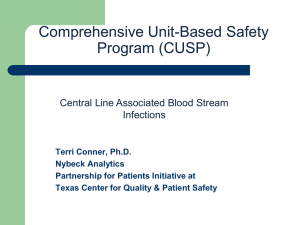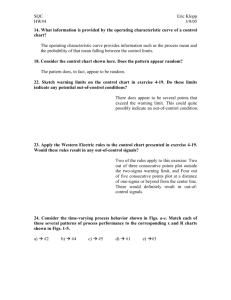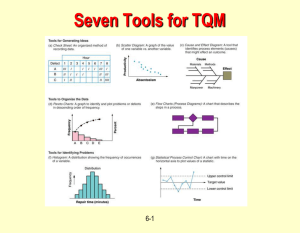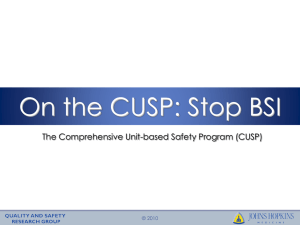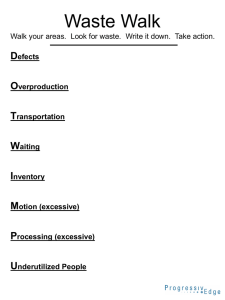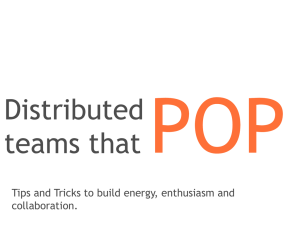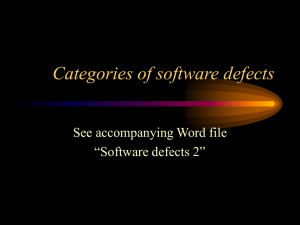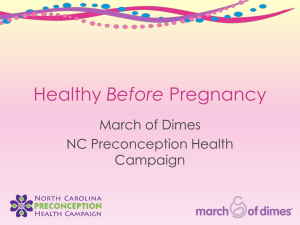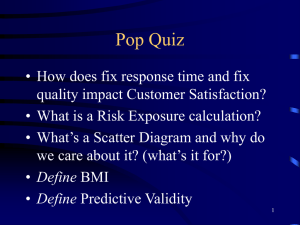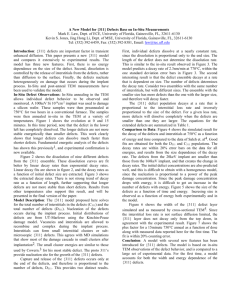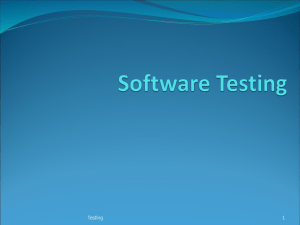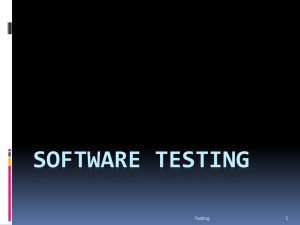Surgical Unit-Based Safety Program
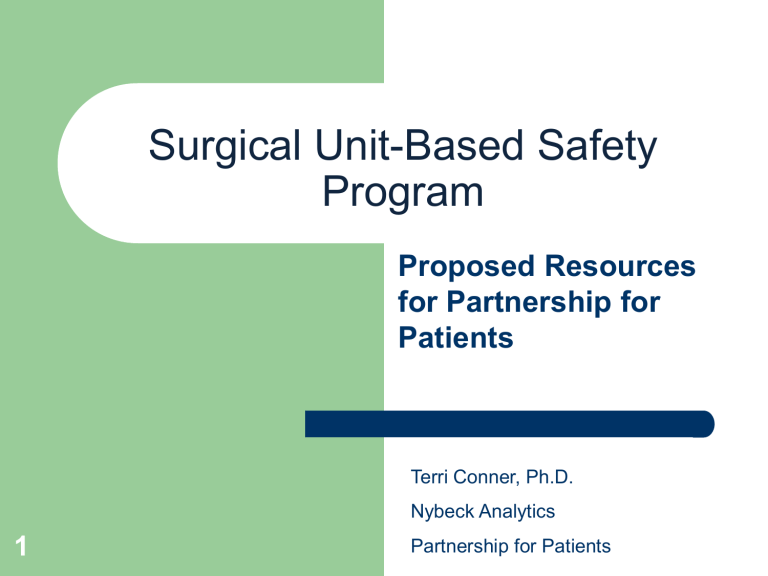
1
Surgical Unit-Based Safety
Program
Proposed Resources for Partnership for
Patients
Terri Conner, Ph.D.
Nybeck Analytics
Partnership for Patients
HOSPITALIZATIONS ARE RISKY
2
In the U.S.
– 7% of patients suffer a medication error
–
–
On average, every patient admitted to the ICU suffers an adverse event
44,000 – 98,000 people die in hospitals each year as the result of medical errors
– An additional 100,000 deaths from health-care associated infections
– Cost of HAI is $28-33 billion
SURGERY IS RISKY
3
25% of in-patient surgeries are followed by a complication, many leading to:
– Prolonged LOS
– Re-admission
– Death
50% of all hospital adverse events are linked to surgery
– At least 50% of adverse surgical events are preventable
4
5
PROJECT GOALS
To achieve significant reductions in surgical site infection and surgical complication rates
– Reducing complications reduces readmissions
To achieve significant improvements in safety culture
6
IMPORTANT POINTS
Harm is preventable
– Many HAIs and complications are preventable, and should be viewed as defects
Technical and adaptive work
– Focus on systems; not on individuals
– Engage frontline staff to identify and fix local opportunities to improve
7
SUSP
Not Just a Checklist Program
Informed by science
– Medical best evidence
– Social science
Led by clinicians and supported by management
Guided by measures
SUSP INTERVENTIONS
8
No single SSI prevention bundle
– Dive deeply into SCIP measures to identify local defects
– Emerging evidence
Bowel prep
Antibiotic redosing
Chlorhexidine skin prep
Capitalize on frontline wisdom to identify local opportunities to improve
9
HOW WILL WE GET THERE?
SUSP
Technical component
– TRIP: Translating Evidence into Practice
Adaptive component
– CUSP: Comprehensive Unit-based Safety
Program
10
SUCCESSFUL EFFORTS
Michigan Keystone ICU program
– Reduction in central line-associated blood stream infections
– Reduction in ventilator-associated pneumonias
11
TRIP: Translating Evidence Into
Practice
Summarize the evidence
Identify local barriers to implementation
Measure performance
Ensure all patients get the evidence
–
4 E’s Model
12
4 E’S MODEL TO HELP IMPLEMENT
PATIENT SAFETY INTERVENTIONS
Engage
– How does this make the world a better place?
Educate
– What do we need to know?
Execute
–
–
What do we need to do?
What keeps me from doing it?
– How can we do it with our resources and culture?
Evaluate
– How do we know we improved safety?
CUSP
Comprehensive Unit-based Safety Program
An intervention to learn from mistakes and improve safety culture
13
A good approach whenever there is a gap between evidence-based practice and current practice on your unit.
CUSP: EMPHASIS ON CULTURE
Shared attitudes, values, goals, practices, behaviors
14
Culture influences behavior
– Participation in quality improvement efforts
– Communication
Breakdown in communication contributes to nearly all adverse events.
15
CUSP: COMPREHENSIVE UNIT-
BASED SAFETY PROGRAM
Safety practices part of daily work
Implemented at the unit level
Led by clinicians
Structured program, yet flexible
PRE-CUSP STEPS
16
Assemble Safety Team
– Multidisciplinary
– Different levels of experience
– Encourage joining team at any phase of the program
PRE-CUSP STEPS
17
Team Members – frontline staff
– Project Leader (Unit Champion)
– Nurse Manager
– Physician Champion
– Senior Hospital Executive
–
–
Patient Safety Coordinator
Epidemiology / Infection Control
– Coach
PRE-CUSP STEPS
18
Measure Safety Culture
– Before CUSP implementation, and then every 12-18 months
–
Use AHRQ’s The Hospital Survey on Patient Safety Culture
(HSOPS)
– All clinical and non-clinical providers
– Report results to the unit and senior hospital executive
CUSP STEPS
19
1.
Science of safety training
2.
Identify defects
3.
Assign executive to adopt unit
4.
Learn from defects
5.
Implement teamwork tools
STEP 1: SCIENCE OF SAFETY
TRAINING
20
Goals
– Magnitude of patient safety problem
– Foundation for investigating safety defects
–
Providers’ involvement significantly affects patient safety
21
STEP 1: SCIENCE OF SAFETY
TRAINING
Learning Objectives
– Safety is a property of the system
– Use strategies to improve system performance
Standardize work
Create independent checks for key processes
Learn from mistakes
– Apply strategies to both technical work and team work
– Teams make wise decisions with diverse and independent input
STEP 1: SCIENCE OF SAFETY
TRAINING
22
Training Session
– 3part “Improving Safety” presentation by Dr. Peter Pronovost
Part 1: http://www.youtube.com/watch?v=GOJJHHm7lnM
Part 2 http://www.youtube.com/watch?v=wpzb7nM6oFQ&feature=related
Part 3 http://www.youtube.com/watch?v=6BnXs4KtER8&feature=related
– Instruct staff on reporting of safety concerns
– Describe executive safety rounds
STEP 2: IDENTIFY DEFECTS
23
Eyes and ears of patient safety
Ongoing process
Disseminate Staff Safety Assessment Form
Combine results and prioritize defects
24
WHAT IS A DEFECT?
Anything you do not want to have happen again.
Many HAIs are preventable. They should be viewed as defects.
STEP 2: IDENTIFY DEFECTS
25
Staff Safety Assessment Form
– Purpose: Tap into your knowledge and experiences at the frontlines of patient care to find out what risks are present on your unit that do or could jeopardize patient safety.
– All health care providers in the unit complete this form.
– 2-item questionnaire
STEP 2: IDENTIFY DEFECTS
26
Staff Safety Assessment Form
1.
Please describe how you think the next patient in your unit/clinical area will be harmed.
2.
Please describe what you think can be done to prevent or minimize this harm.
27
STEP 2: IDENTIFY DEFECTS
Combine Results
– Group into common types of defects
Communication
Medication process
Patient falls
Supplies
– Frequency distributions
Example: communication, 57%
28
STEP 2: IDENTIFY DEFECTS
Prioritize safety concerns
– Obtain input from CUSP team senior executive
– Prioritize based on
Likelihood of causing patient harm
Severity of harm
How common is the problem
Likelihood it can be solved by implementing a daily work process
29
STEP 4: LEARN FROM DEFECTS
Four Key Questions
1.
What happened?
2.
Why did it happen?
3.
4.
What will you do to reduce the chance it will recur?
How do you know that you reduced the risk that it will happen again?
30
WHAT HAPPENED?
Reconstruct the timeline and explain what happened
Put yourself in the place of those involved, in the middle of the event as it was unfolding
Try to understand what they were thinking and the reasoning behind their actions/decisions
Try to view the world as they did when the event occurred
31
WHY DID IT HAPPEN?
SYSTEM FAILURES
Arise from managerial and organizational decisions that shape working conditions
Often results from production pressures
Damaging consequences may not be evident until a “triggering event” occurs
Develop lenses to see the system factors that lead to the event
32
WHAT WILL YOU DO TO REDUCE
THE RISK OF IT HAPPENING AGAIN?
Prioritize most important contributing factors
Prioritize most beneficial interventions
Safe design principles
– Standardize what we do
– Create independent check
– Make it visible
Safe design applies to technical and team work
33
WHAT WILL YOU DO TO REDUCE
THE RISK OF IT HAPPENING AGAIN?
Develop list of interventions
For each intervention:
– Rate how well the intervention solves the problem or mitigates the contributing factors for the accident
– Rate the team belief that the intervention will be implemented and executed as intended
Select top interventions (2 to 5) and develop intervention plan
– Assign person, task follow-up date
34
HOW DO YOU KNOW RISKS WERE
REDUCED?
Did you create a policy or procedure?
Do staff know about policy or procedure?
Are staff using the procedure as intended?
– Behavior observations, audits
Do staff believe risks were reduced?
STEP 4: LEARN FROM DEFECTS
35
Summarize and Share Findings
– Learning from Defects Tool
–
Detailed form for each incident or identified defect
Case Summary Form
Summarize the case
Identify system failures
Identify opportunities for improvement
List actions taken to prevent future harm
– Share your findings
STEP 4: LEARNING FROM
DEFECTS
36
Key Points
– Focus on systems, not people
– Prioritize
– Go mile deep and inch wide, rather than mile wise and inch deep
– Pilot test
– Learn from 1 defect a quarter
– Answer the four questions
37
STEP 5: TEAM WORK TOOLS
Staff Safety Assessment
Safety Issues Worksheet
Status of Safety Issues
Learning from Defects Tool
Case Summary Form
Briefings/Debriefings
SSI Investigation
Audits
STAFF SAFETY ASSESSMENT
38
Used to identify defects in the unit
1.
Please describe how you think the next patient in your unit/clinical area will be harmed.
2.
Please describe what you think can be done to prevent or minimize this harm.
39
SAFETY ISSUES WORKSHEET
Identified Issue
1.
2.
3.
Potential/
Recommended
Solution
Resourc es
Needed
Resources
Not
Needed
Date
STATUS OF SAFETY ISSUES
Safety Issue
New and Ongoing
Contact Status Goal
New and Ongoing
Contact Status Date Safety Issue Goal
40
Date Safety Issue
Completed
Contact Status Goal
LEARNING FROM DEFECTS
41
Explain what happened.
Check off the factors that negatively or positively contributed to the incident.
Describe how you will reduce the likelihood of this defect happening again by completing the tables.
Develop interventions, and choose 2-5 to implement.
–
–
–
What will be done?
Who will lead the intervention?
When is follow-up?
Describe how you know you have reduced the risk.
Summarize your findings using the Case Summary Form.
CASE SUMMARY FORM
42
Form Sections
Safety tips
Case summary
System failures
Opportunities for improvement
Actions taken to prevent harm
BRIEFINGS / DEBRIEFINGS
43
Dominant tool for SUSP
Growing evidence
– Better team performance
– Better safety culture
– Reduction in delays
Adapted to local hospital and OR
Adapted to surgery type
44
SSI INVESTIGATION TOOL
Look into factors that may be systematically contributing to SSIs
45
AUDITS
Skin prep audits
Antibiotic audits
46
OTHER TOOLS
Mislabeled specimens
Wrong sided surgery
Retained foreign objects
47
